This article first appeared in the special feature Understanding the Impact of Climate Change.

Species distribution models are used to predict species geographical patterns in response to ongoing and anticipated climatic changes. Dr. Irene Alabia, who uses species distribution modeling to study biodiversity trends in the Arctic seas, spoke about how she uses available species observations and environmental data to predict changes in these waters over short and long timescales.
Seas surrounding the Arctic are vital for fisheries
The Arctic differs from the Antarctic in that there is no land mass occupying the area around the North Pole. The vast waters surrounding the Arctic are home to a variety of marine species, many of which are important to human diets. Regions such as the Eastern Bering Sea are among the most productive ecosystems in the world, supporting large commercial and subsistence fisheries. The effects of global warming disproportionately affect the different sub-Arctic and Arctic marine areas, highlighting its cascading impacts on fisheries.
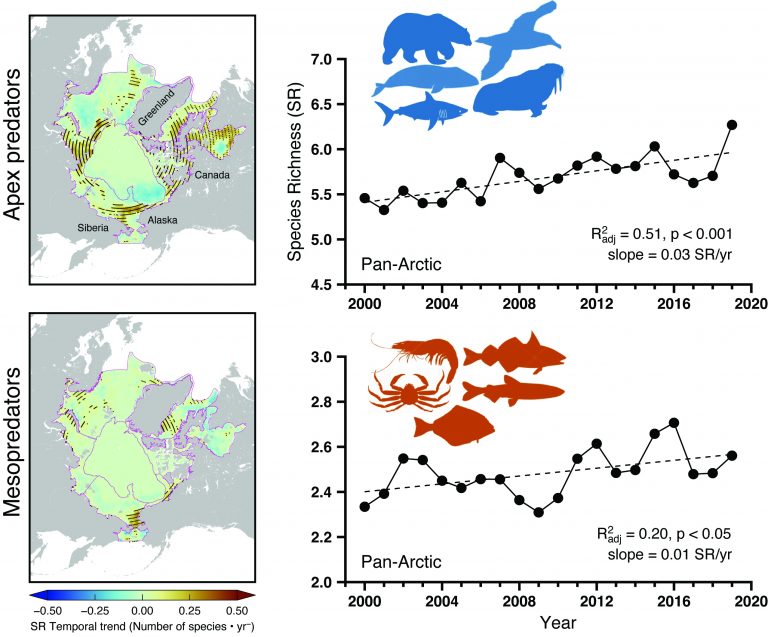
Modeling uses historical data to predict present and future species distributions
My research involves the construction and interpretation of species distribution models and their outputs to elucidate biodiversity changes over time. We use species observations collected from fish surveys and environmental data to construct these models to predict current and future species distributions. Specifically, the models I use combine species occurrence data with climate information across the same period to infer and map potential species habitats and presence in space. We then look at how the species-specific potential habitat distributions changed over time in response to changing climatic conditions during the given period.
These statistical-based species distribution models can also be used to predict future distributions. The models’ predictive accuracy is often improved with the inclusion of more and recent data when they become available, allowing a better characterization of the potential geographical range of species distributions. This is important when applying these models to map species distributions under future climatic conditions.
One of the advantages of the models I use is the ease of implementing them over large datasets in space and time, allowing us to make projections of species distribution changes across contrasting scenarios of climate change. This enables us to run and examine multiple simulations across subsets of species in the marine communities and elucidate climate scenario-based biodiversity responses.
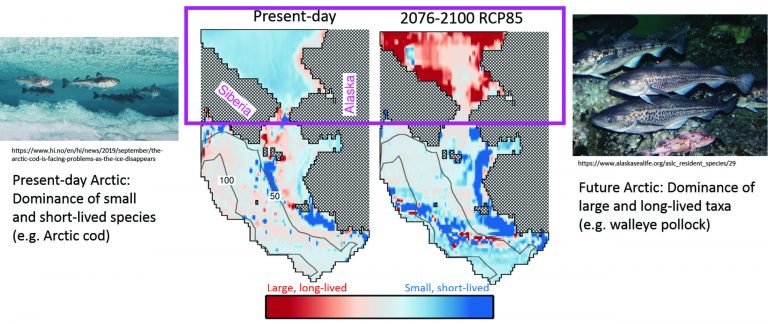
Climate change is altering the productivity of sub-Arctic and Arctic seas
The Eastern Bering Sea is one of the most productive marine ecosystems on the planet. It supports one of the largest pollock fisheries in the world. Just like any other seas surrounding the Arctic region, this area has experienced significant warming and sea ice loss in recent decades. What we’re seeing in our models is that species are responding to these climatic changes differently. For instance, species that are adapted to warmer waters are moving northwards, into areas where they were not previously found. However, species that cannot adapt to warmer waters have to move further northwards, albeit at rates slower than warm-adapted taxa, disappearing from areas they once occupied.
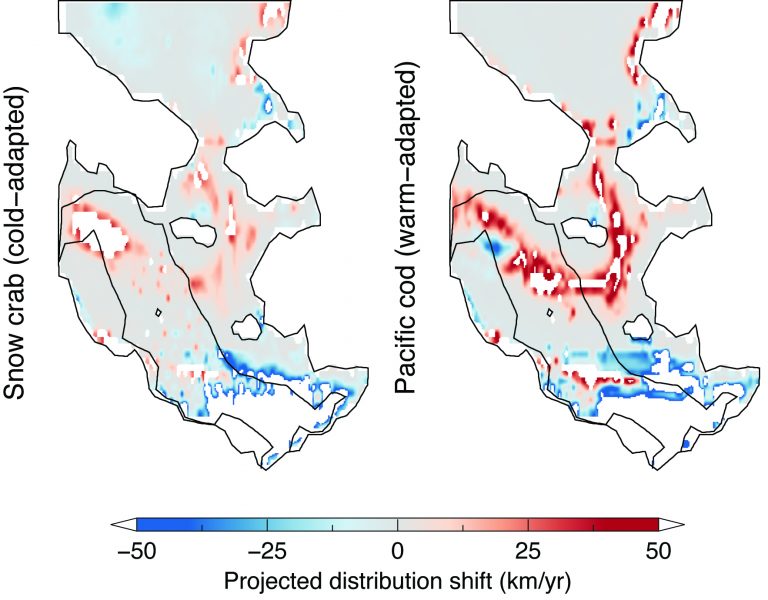
On the other side of the globe is the Barents Sea. This is also an Arctic Sea that is extremely productive and supports a large number of commercial fisheries. The poleward changes that our models have revealed in the Eastern Bering Sea are also reported to occur in the Barents Sea.
Simple models can give meaningful predictions
The models that I use are simple correlative models of species distribution. We take, for example, ten years of data of sustained sampling of species in a region, and relate those with the ambient temperature, and other abiotic factors, along with primary productivity in space and time. The end results are probability maps of species distributions based on their preferred environmental conditions, mapping the locations where the species are most likely to be found—outside of the model-inferred optimal environmental ranges, the probability of finding them is low. This allows us to rerun our models with more species observation data when available and come up with better estimates of where the species are going to be, where they like living and where they might be in the future, should the changes in climate ensue.

As the availability of preferred environmental ranges of the species is anticipated to change with climate, those that cannot adapt are likely to lose their habitats and models are likely to predict these species losses. However, it is important to note that our sampling points may only be capturing a portion of the species geographical range, and may not fully represent the entirety of species distributional responses. Hence, the need for sustained surveys and monitoring to better inform our models.
Another particularly interesting outcome of our research is that we have also discovered two marine biodiversity refugia in the Eastern Bering Sea over the last 29 years. These refugia are areas where biodiversity has increased and community composition remained the same over time, despite recent changes in climate. This implies that these areas are productive and are able to shelter species against the effects of pronounced warming and sea ice loss in recent decades.
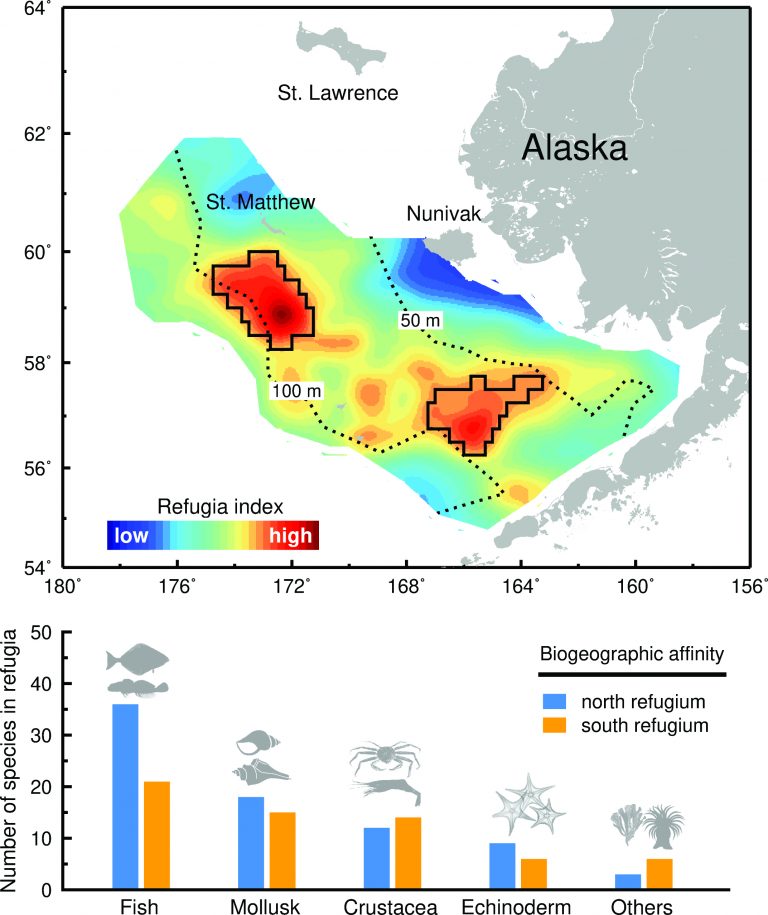
Nature is complex and dynamic
As a researcher working with models, I seldom have the opportunity to work in the field and often relied on data collected by observational scientists and shared on public data portals. With models, we are able to work with whatever available data are currently on-hand while allowing us to generate scenario-based predictions. This process gives us a peek at the dynamics and complexities of nature: often there is no single generalization that can explain natural phenomena and responses, even those transpiring at the seas I study. It is humbling—and exciting—to realize that there are a lot of things we do not know yet, a lot of things that are left for us to discover.
Modeling biodiversity changes helps prepare for the future
Seafood in general makes up a large part of the diet in many coastal regions across the globe. In island nations like the Philippines and Japan, they are also inextricably linked to the culture. As the seas continue to warm, some of the species that we have come to consider as staples are anticipated to disappear, and perhaps be replaced by new ones. An example is the snow crab, a popular and expensive delicacy in Japan. This species is adapted to cold waters and a warming ocean poses a significant threat to its distribution, abundance, and potential availability to fisheries. With warming waters, their thermal habitats are getting smaller and their distributions are likely to shift away from traditional fishing grounds. Very recently, snow crab fisheries collapse in the Eastern Bering Sea was reported and likely tied to climate change.
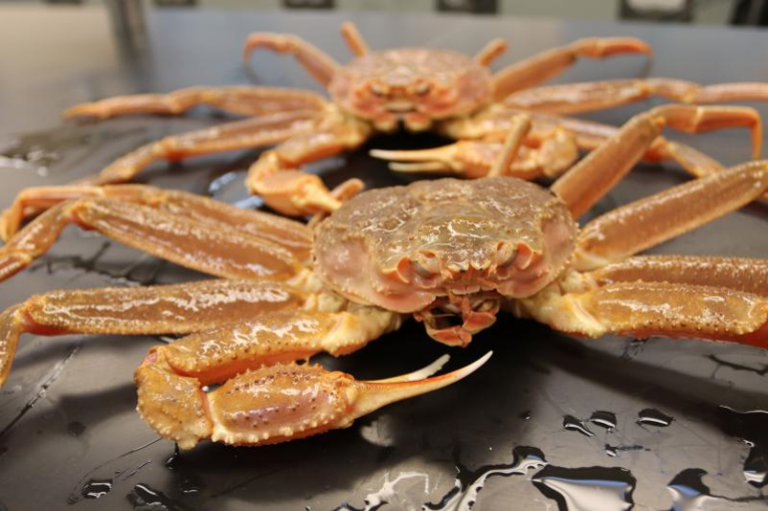
Models can help us predict how species distribution will respond to climatic changes. Insights from these models can be used to inform conservation strategies and sustainable fishing practices. They could also help us to anticipate and mitigate the negative effects of rapid climate changes on fisheries—when fisheries collapse, they not only have ecological impacts but of equal importance are their respective social (e.g., loss of food sources) and economic (e.g., loss of jobs and income streams) repercussions.
Passion and curiosity are key to my research
Pursuing research in my chosen field is something that I am passionate about, and this keeps me going through the hard work and constant learning that research requires. I would like to be part of the solution to the many challenges of climate change on our oceans. I would also love to share my research with others that it may also kindle curiosity and interest, especially among the younger generations.
Those considering a career in research: dare to explore your interests. Ask questions, both easy and hard, and follow where the answers take you—your passion and curiosity will help you determine if you want to go further down the path. There are many things yet waiting to be understood and discovered.

Driven by the Desire for Knowledge
I finished university with a very different goal than what I initially intended: I was enrolled in a pre-medical course and ended up doing marine science research instead. During my third year at university, I took a class in ecology where we went out for fieldwork at sea. The realization that there was so much I do not know about the ocean was extremely enticing: I wanted to know more about the ocean and the creatures below it.
So, I changed course. After I graduated, I started working in marine science, while also pursuing a master’s degree in the same field. This set-up worked well as my research job involved plenty of fieldwork, and the postgraduate course provided me with the knowledge and tools to interpret patterns from field observations and explore mechanisms that are likely driving them—and this in turn, served as a motivation for pursuing further research.
Part of the special feature Understanding the Impact of Climate Change


